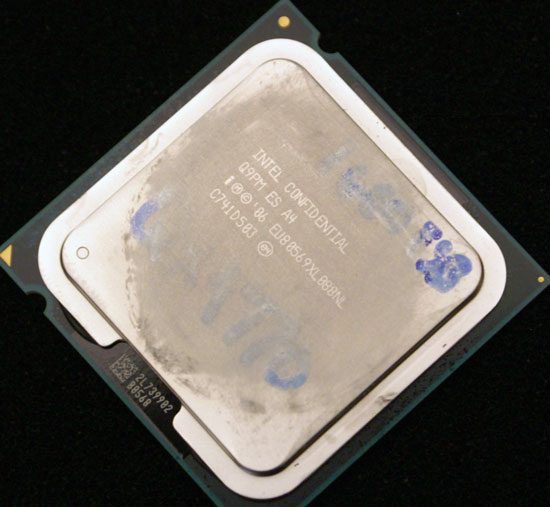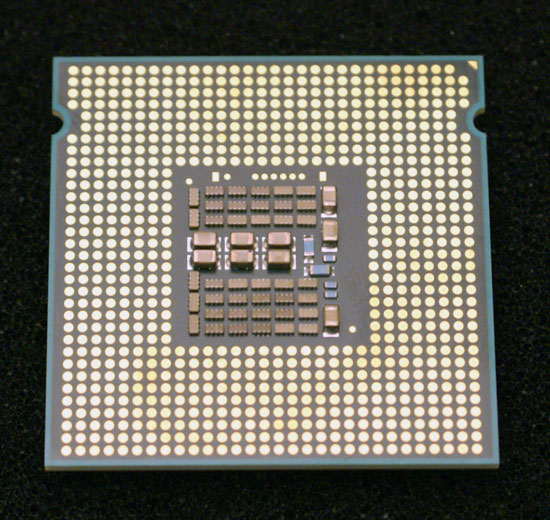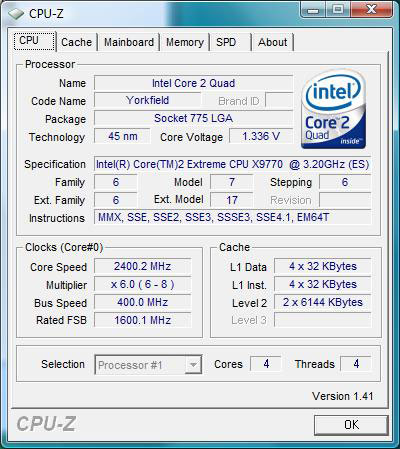Intel's Core 2 Extreme QX9770 Preview - Updated
by Anand Lal Shimpi on November 19, 2007 12:02 AM EST- Posted in
- CPUs
Updated: We're working with Intel on the source of the thermal problems we mentioned in this review, it looks like the culprit was our ASUS P5E3 Deluxe motherboard. ASUS has since released an updated BIOS intended to address the power consumption issues we faced, you can read more about it here while we continue with our testing.
Intel plays dirty.
The closer I got to receiving a Phenom from AMD, the more Intel started dropping hints that it would be sending me something new. One day a box arrived, inside it was this chip:

What you're looking at is an Intel CPU that won't be out until Q1 next year, it's the Core 2 Extreme QX9770. We received it within a matter of weeks of us publishing our last Core 2 Extreme review.

You have to understand Intel's motivation for this launch, because the old Intel would never have sent these chips out. The old Intel would've worried about cannibalizing current Core 2 Extreme sales by talking about a new processor this soon after a launch. The new Intel though, that's a different story.
Today is supposed to be AMD's Phenom launch, which it is, but it's just not a very strong one. AMD is still struggling with low clock speeds, and the release simply wasn't the bang you'd expect from the first real successor to the almighty K8. Rather than give AMD even a moment to regain composure, Intel attempted to disrupt the Phenom launch by sampling the QX9770.
Literally within days of AMD telling me when the Phenom NDA would lift, Intel told me the NDA date of the QX9770 previews - and what a coincidence that was.
To AMD's benefit, the QX9770 doesn't compete even remotely in the same price range as any of its Phenom processors we talked about today. To avoid hurting QX9650 sales, the QX9770 will actually carry a price tag greater than $1000 when it arrives in Q1 2008.
Like its cheaper sibling, the QX9770 is based on Intel's new 45nm Penryn core. The quad-core chip is virtually identical to the QX9650 we reviewed last month with two major exceptions: it runs at 3.2GHz and it uses a 1600MHz FSB.

The 3.2GHz speed bump is nothing earth shattering, it's a 6.7% increase in clock speed over the QX9650, but the 1600MHz FSB on the other hand is a big deal. The FSB frequency increase itself isn't even the important part, what's key here is that Intel doesn't have any chipsets out officially with 1600MHz FSB support, yet it's sampling QX9770s to reviewers.
The old Intel would've waited for the X48 chipset, which will bring official 1600MHz FSB support. The old Intel wouldn't have even recognized the QX9770 as existing on its roadmap. The new Intel not only pre-announced the chip, but it also encouraged reviewers to overclock X38 chipsets to support the 1600MHz FSB required by the QX9770.

Our QX9770 testbed, an overclocked X38 motherboard
If I'm working at AMD today I'm not worried about the specs of the QX9770, I'm worried that Intel sent these things out for review.
We've already looked at what Penryn can offer in our QX9650 review and our Wolfdale Preview. If you want to understand the architecture behind Intel's new 45nm chips be sure to read some of our earlier articles.










27 Comments
View All Comments
supremelaw - Monday, November 19, 2007 - link
http://www.anandtech.com/cpuchipsets/intel/showdoc...">http://www.anandtech.com/cpuchipsets/intel/showdoc...
"... switching to a newer Intel retail heatsink/fan
fixed my issues well enough for me to run through all the tests."
Yep! Same 4 defective fasteners:
http://www.anandtech.com/cpuchipsets/intel/showdoc...">http://www.anandtech.com/cpuchipsets/intel/showdoc...
Sincerely yours,
/s/ Paul Andrew Mitchell
Webmaster, Supreme Law Library
http://www.supremelaw.org/">http://www.supremelaw.org/
sprockkets - Tuesday, November 20, 2007 - link
It does not explain, however, the increased power usage. In any case, the HSF mounting mechanisms on Intel's chips since the P4 have been subpar at best. First, they post warnings about how they can bend but not damage motherboards, then they switch to the current scheme. AMD's system since the K8 is simple: provide proper bracing on and under the mb and you are set.jones377 - Monday, November 19, 2007 - link
?acx - Monday, November 19, 2007 - link
Chips can have varying levels of leakage current from batch to batch or even within the same batch. The difference between the lowest leakage chip vs. highest leakage chip can be quite large. Chips with high leakage are usually faster than chips with lower leakage. The power draw is probably due to high leakage because of the large increase in idle power usage of QX9770 vs QX9650 (58W). Subtracting 58W from QX9770's full load power consumption yields 209W. This is 9% more than QX9650's power consumption under full load. This is a more reasonable difference in power consumption given the increase in clock speed and FSB. Leakage also increases at higher temperatures. A very fast part on the borderline of acceptable leakage may fail at lower temps than a slow chip with more leakage margin.MrKaz - Monday, November 19, 2007 - link
Could you do some double check the CPU voltage?How the power consuming grow up so much for just 200Mhz increase?
(It’s 4 x 200Mhz) but even so.
Is Intel getting the same P3 1.133MHZ bug? Where the Pentium 3 couldn’t be clock more than 1.000MHZ? But this time hit at 3.2GHZ.
Or is this CPU manufactured in some other less "qualified" Intel factory?
Could you under clock it to make sure?
swaaye - Tuesday, November 20, 2007 - link
The voltage is definitely hig. Default should be around 1.25v, and that's for the 65nm Q6600. I see 1.336v being reported. That's where the power consumption is coming from.xsilver - Monday, November 19, 2007 - link
Could somebody explain why after only 2 years after the death of netburst and its super high power envelope, we are stuck in the same situation again?Also is there anything being done for future processors to rectify this problem? (besides die shrink that is)
retrospooty - Monday, November 19, 2007 - link
I think there was some other issue going on here that should have been looked into before posting the article. Most reviews of the 3ghz/1333fsb model are clocking up to 4ghz on air - now we are saying the 3.2 has issues with heat? come on, get real.mindless1 - Monday, November 19, 2007 - link
Obviously it's true, since they did measure a significant increase in power consumption which has to end up as heat. Granted some comes from the higher FSB, a very small amount only!I will speculate that one of two things is true:
1) This sample needed higher voltage to remain stable than what they eventually plan on selling through channels. They'll release their spec sheet and then we'll see, but really the numbers don't look too outlandish given the clock speed and quad cores, if the vcore is raised a bit.
2) The motherboard VRM subcircuit isn't able to handle this current level so well and excessive ripple causes higher consumption.
What would be interesting is to use the better heatsink and lower the vcore a notch to see if that regains a bit of stability, or of course to try it on more motherboards.
murphyslabrat - Wednesday, November 21, 2007 - link
OMG, can we only hope?!?If Intel responded this quickly, with a shoddy product to boot, could this mean that they are afraid of Barcelona/Agena?